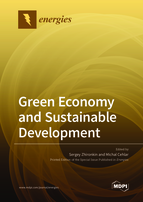Green Economy and Sustainable Development
A special issue of Energies (ISSN 1996-1073). This special issue belongs to the section "A: Sustainable Energy".
Deadline for manuscript submissions: closed (1 February 2022) | Viewed by 37386
Special Issue Editors
2. Department of Economy and Planning, Siberian Federal University, 660075 Krasnoyarsk, Russia
Interests: sustainable development; neo-industrial economy; Industry 4.0; environmental risks
Special Issues, Collections and Topics in MDPI journals
Interests: green economy; Industry 4.0 in basic industries; sustainable development
Special Issues, Collections and Topics in MDPI journals
Special Issue Information
Dear Colleagues,
At present, increased environmental requirements for the development of industry, especially the key branches, are facilitating changes in the structure of the global economy, propelling the countries and companies that are most active in promoting environmental innovations to the top of the competition. The green economy is facing the challenge of not only preserving the environment, but also ensuring sustainable development as a comprehensive satisfaction of human needs in modern goods and improving the ecosystem. An important role in this process belongs to the technological development of mining and processing of minerals, the revitalization of depleted deposits, and the development of revolutionary new sources of energy. At the same time, for the sustainable development of the global economy and modern society, it is equally important to search for new forms of interaction between business and state, science, and society to accelerate the introduction of green technologies and attract investments in the environmental modernization of industry. Modern technologies of Industry 4.0 are implemented in lean production, integrative use of natural resources and their recycling, and replacement of traditional energy sources with alternative ones. These transform the coal, oil and gas industries, energy production, metallurgy, and transportation.
The purpose of the Special Issue is to unite the efforts of researchers from all over the world to expand a pluralistic vision of the problems of green economy and sustainable development, innovative development of technologies for integrated extraction, and non-waste processing of minerals. Today, it is important to join the efforts of researchers from different countries in order to combine engineering thought with the scientific rationale for greening the economy, processing industrial and municipal waste, and purifying industrial water and polluted air.
Articles selected for this Special Issue on “Green Economy and Sustainable Development” will be subject to a peer-review procedure with the aim of rapid and wide dissemination of fundamental and practical research results.
We invite you to submit your original papers to this Special Issue on “Green Economy and Sustainable Development” and look forward to receiving your outstanding research.
Prof. Dr. Sergey Zhironkin
Prof. Dr. Michal Cehlar
Guest Editors
Manuscript Submission Information
Manuscripts should be submitted online at www.mdpi.com by registering and logging in to this website. Once you are registered, click here to go to the submission form. Manuscripts can be submitted until the deadline. All submissions that pass pre-check are peer-reviewed. Accepted papers will be published continuously in the journal (as soon as accepted) and will be listed together on the special issue website. Research articles, review articles as well as short communications are invited. For planned papers, a title and short abstract (about 100 words) can be sent to the Editorial Office for announcement on this website.
Submitted manuscripts should not have been published previously, nor be under consideration for publication elsewhere (except conference proceedings papers). All manuscripts are thoroughly refereed through a single-blind peer-review process. A guide for authors and other relevant information for submission of manuscripts is available on the Instructions for Authors page. Energies is an international peer-reviewed open access semimonthly journal published by MDPI.
Please visit the Instructions for Authors page before submitting a manuscript. The Article Processing Charge (APC) for publication in this open access journal is 2600 CHF (Swiss Francs). Submitted papers should be well formatted and use good English. Authors may use MDPI's English editing service prior to publication or during author revisions.
Keywords
- green economy
- sustainable development
- key branches
- environment-saving industrial technologies
- environment-protecting strategy







